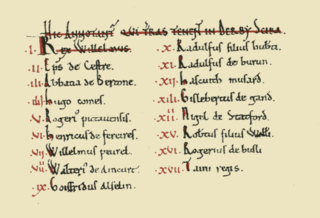Related Research Articles
Robert de Mowbray, a Norman, was Earl of Northumbria from 1086 until 1095. Robert joined the 1088 rebellion against King William II on behalf of Robert Curthose, but was pardoned and later led the army that killed Malcolm III of Scotland at Alnwick. In 1095, he conspired to put Stephen of Aumale on the throne, was besieged by the king, and captured. As punishment, his marriage was dissolved and his lands confiscated, given to the new husband of his former wife, while Mowbray was imprisoned for life and later became a monk.
Roger de Busli was a Norman baron who participated in the conquest of England in 1066.
Juhel de Totnes, Latinised to Judhellus filius Aluredi, "Juhel son of Alured") was a soldier and supporter of William the Conqueror (1066–1087). He was the first feudal baron of Totnes and feudal baron of Barnstaple, both in Devon.

Little Dunmow Priory in Little Dunmow was an Augustinian priory in Essex, England. The priory was founded as a church by Juga de Baynard in 1104, dedicated to the Blessed Virgin Mary and consecrated by Maurice, bishop of London. Juga was the widow of Ralph Baynard, baron of Little Dunmow, sheriff of Essex and builder of Baynard's Castle in the City of London, since demolished. Her son Geoffrey was sheriff of Yorkshire who, in 1097, beat William II, Count of Eu in a trial by battle. After her death (c.1106), and following her wishes and the advice of Anselm, the Archbishop of Canterbury, Geoffrey populated Juga's church with Augustinian canons. In 1110, Lady Juga’s grandson, and Geoffrey’s son, William de Baynard, fell from grace and lost his lands. Henry I gave those lands to Robert Fitz Richard, but Henry and his wife Matilda of Scotland confirmed the canons’ possessions in Little Dunmow. Robert’s wife Maud, the step-daughter of Matilda’s brother David I, gave more lands to the canons, establishing the priory in perpetuity.

In the kingdom of England, a feudal barony or barony by tenure was the highest degree of feudal land tenure, namely per baroniam, under which the land-holder owed the service of being one of the king's barons. The duties owed by and the privileges granted to feudal barons are not exactly defined, but they involved the duty of providing soldiers to the royal feudal army on demand by the king, and the privilege of attendance at the king's feudal court, the Magnum Concilium, the precursor of parliament.

William I (Willame) de Percy (d.1096/9), 1st feudal baron of Topcliffe in North Yorkshire, known as Willame als gernons, was a Norman nobleman who arrived in England immediately after the Norman Conquest of 1066. He was the founder via an early 13th-century female line of the powerful English House of Percy, Earls of Northumberland, and via an 18th-century female line of the Dukes of Northumberland.
Richard fitz Eustace was Constable of Chester and Baron of Halton within the County Palatine of Chester ruled by the Earl of Chester.
William de Courcy, feudal baron of Stoke Courcy in Somerset, was an Anglo-Norman nobleman.
William Meschin was an Anglo-Norman nobleman and baron. The brother of the earl of Chester, Meschin participated in the First Crusade. After returning to England, he acquired lands both from King Henry I of England and by his marriage to an heiress.
Hasculf de Tany was an Anglo-Norman nobleman who lived in medieval England, in the region of London. He is believed to have been castellan of the Tower of London.

The Domesday Book of 1086 lists in the following order the tenants-in-chief in Devonshire of King William the Conqueror:

The feudal barony of Appleby was a feudal barony with its caput at Appleby Castle in Appleby, Westmorland, England.
Adam de Port was an Anglo-Norman nobleman and Baron of Kington.
Robert, Count of Eu and Lord of Hastings, son of William I, Count of Eu, and his wife Lesceline. Count of Eu and Lord of Hastings.

John, Count of Eu,, son of Henry I, Count of Eu, and Marguerite, daughter of William, Count of Sully. John was Count of Eu and Lord of Hastings.
Hugh de Beauchamp was a Norman who held lands in England after the Norman Conquest.

John fitz Richard was an Anglo-Norman soldier, Baron of Halton and hereditary Constable of Chester. Historical records refer to him as "John, Constable of Chester". He died at Acre in the Holy Land.

The Constable of Chester was a mediaeval hereditary office held by the Barons of Halton. The functions of the Constable are unclear, possibly they related to the custody of Chester Castle, as was the main function of most mediaeval constables, but Sanders (1960) says the office-holder was constable for the entire County Palatine.

The Domesday Book of 1086 AD lists King William the Conqueror's tenants-in-chief in Derbyscire (Derbyshire), following the Norman Conquest of England:
Nigel Fossard was an Anglo-Norman nobleman who held the honour of Mulgrave in Yorkshire and by virtue of that is considered the feudal baron of Mulgrave.
References
- 1 2 3 4 5 6 7 8 Sanders 1960, p. 119.
- 1 2 3 Barlow 2000, p. 357.
- ↑ Cownie 1998, p. 213.
- ↑ Sanders 1960, p. 147.